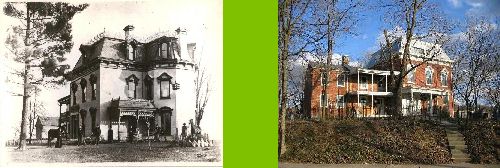Monday, November 27, 2006
I'm Stripping Again
Once again I find myself stripping paint from woodwork and a combination of tar, glue, paint and shellac from the floor. I no longer get frustrated doing this because I know and accept that it will take "forever" to complete. I spent 6 hours Saturday on the floor with heat gun and Silent Paint Remover switching between the two and got maybe 15 square feet of floor done. At this rate it will be a while before the floor and molding is ready for sanding. The good news is that I will be painting the woodwork and the floor in this room so I don't have to do a perfect job at stripping. The other good news is that it is one of only two rooms left in the entire house where I have to strip floors or molding. (There are still at least six doors though.) It seems to me that I always end up stripping paint in the winter Actually, it seems to me that I am stripping all year. It is just that I only remember doing it in the winter! Maybe it's a hot and cold thing. Maybe I've inhaled too many fumes.......
Subscribe to:
Post Comments (Atom)

3 comments:
Hello Gary,
I've been going through your past posts with regards to painting trim. I noticed you go back and forth between paint and no paint and wanted to know why. Is it just personal preference? Also, since I've deicided to paint all of my woodwork white, should I leave the doors their natural wood color? I am going to strip these too anyway but I'm thinking about adding analine dye to make them a nice really dark color instead of white like the door casings and baseboard just to offer some contrast to the white. What do you think?
Sorry this hasn't much to do with your post but you seem to be more together than many of us.
Thanks
To answer your questions. I tend not to wear a mask when stripping paint. I wear one when sanding though. I'm not overly concerned about the lead paint. I don't think we have tons of it though I'm sure some is there. White is the biggest culprit and we don't have a lot of white. Since we aren't living in the house yet there is no risk of lead dust getting in my food. The biggest risk is inhaling the stuff and I am the one at risk. If I have elevated lead levels I wouldn't know and a little lethargy might do me some good! I have a greater risk from sawdust which is now considered a carcinogen. When I get the next two rooms done we plan to give the place a thorough cleaning to get rid of all the dust and hopefully most of the lead that may be in the place. The only side effects I suffer from, besides the back ache and the inability to clench a fist for days, are sinus related and probably a result of sweeping the floor more than stripping paint. I did have nausea and vision impairment once many years ago from inhaling the fumes of furniture refinisher and paint stripper for hours while stripping wood in my kitchen.
As for painting and refinishing wood. Some rooms on the second floor have always had painted wood. It ranged in color over the years from dark green through grey and tan to pink, beige and finally blue. It was quite thick and very chipped up and irregular. There was never any shellac applied to the wood to assist with my stripping efforts. In most cases it would be too much effort to strip the wood to a finish worthy of preserving. Besides, much of the wood is pine of inferior quality or consists of different types of wood and would look odd if I shellacked it. In these rooms we have decided to sand the wood, fill all the divits and butchering with putty and Bondo and repaint the wood. On the second floor all the wood will be painted white because white goes with everything and we can use any color on the walls. In the main house, the doors are refinished and look good against the white. I haven't decided what to do with the doors for the rooms I am currently working on, I have to strip them first to see what I have to work with. While some rooms in the main section of the house will look very elegant the ones in the "cottage" side will be quite rustic. Victorian houses generally had painted woodwork. They also had a tendancy to faux finish the woodwork to look like something that it wasn't. The pine in our hall was painted to look like rosewood originally. If you still want a room to look like wood of a uniform type, you can wipe diluted paint over the surface to gice it a uniform color while allowing the grain to show through. Then you shellac over the painted surface.
Thanks a lot for the very detailed explanation. I really appreciate it. I'm going to shellac the doors. Oh how I wish these people had left the woodwork alone but they didn't and I just want to get it done. I did decide to use a clear shellac as a base coat/sealer before the paint gets applied.
Post a Comment